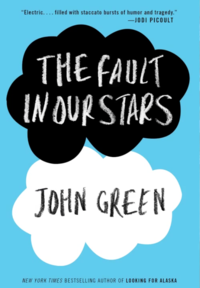Diagnosed with Stage IV thyroid cancer at 12, Hazel was prepared to die until, at 14,a medical miracle shrunk the tumours in her lungs… for now.
Two years post-miracle, sixteen-year-old Hazel is post-everything else, too; post-high school, post-friends and post-normalcy. And even though she could live for a long time (whatever that means), Hazel lives tethered to an oxygen tank, the tumours tenuously kept at bay with a constant chemical assault.
Enter Augustus Waters. A match made at cancer kid support group, Augustus is gorgeous, in remission, and shockingly to her, interested in Hazel. Being with Augustus is both an unexpected destination and a long-needed journey, pushing Hazel to re-examine how sickness and health, life and death, will define her and the legacy that everyone leaves behind.
Despite the tumor-shrinking medical miracle that has bought her a few years, Hazel has never been anything but terminal, her final chapter inscribed upon diagnosis. But when a gorgeous plot twist named Augustus Waters suddenly appears at Cancer Kid Support Group, Hazel’s story is about to be completely rewritten.
Let me begin by saying that I am not a nerdfighter. Although I’ve purchased all of his books for the library, this was my time reading a first John Green novel. I had huge expectations…HUGE! And, well, yeah…I’m not running out to catch up on what I’ve missed, people.
On page 33, our two main characters have met and are getting to know each other. Augustus (Romeo) asks Hazel (faux Juliet) what her story is. She hedges the subject and eventually says that she likes reading…
“What do you read?” [Augustus]
“Everything. From, like, hideous romance to pretentious fiction to poetry.
Whatever.” [Hazel]
It was at this point when I realized exactly how I felt about the book. The style, the wording, the verbose nature of the conversations, thoughts, and readings that the teens took part in were pretentious. It’s almost like Green did it on purpose though as he used the word pretentious repetitively throughout the novel. Honestly, I have no idea why a writer would do that, but I also have no idea why the characters talk like they have a thesaurus glued to their hand and must look up every other word either. I’m sorry; maybe kids in Indiana have better vocabulary skills than the kids here in North Carolina, but I have spent over a decade in a high school and guess what…KIDS DON’T TALK LIKE THEY DO IN THIS BOOK.
The novel opens and introduces us to Hazel, a terminally ill fifteen year old girl with a chip on her shoulder. She’s not really mean, just defeated really. Because she has been pulled out of school, her mother feels that she needs socialization in the form of a cancer support group. Honestly, that seemed like one of the most depressing situations ever, but that is how we begin.
So Green’s initial set-up reminds me of Shakespeare. The prologue to Romeo and Juliet tells you that they are both going to die, and yet, when it happens, teens across the country are shocked and confused…it’s all that crap about true love conquering all that they are fed by Disney. Anyway, the reason why the book reminds me of Shakespeare (other than the title and the constant jabber of being star crossed) is that Hazel is terminal so the reader accepts that she is going to be sick and probably die over the course of the novel. It’s a given, a part of the foreshadowing, something to be taken for granted….or not…
So, let’s cut to the chase, after I realized that Green’s diction was going to be a constant irritation, I began to ignore it, similar to Lisa McMann’s writing style in general. Once the writing itself was out of the picture, the story is really beautiful, not believable, but beautiful. Some of the imagery was actually beautiful too. For instance, page 124, August is reading to Hazel.
“’Mother’s glass eye turned inward,’” Augustus began. As he read, I fell in love the way you fall asleep: slowly, and then all at once.
That is beautiful, and honestly, I found it even more beautiful that it was written by a male author for a female protagonist. I think I’ve used beautiful once for every time that Green used pretentious now.
After experiencing a friend dying from a chronic disease at 21, I felt that the characters emotions and actions were realistic and fascinating. The book was emotional (“like a roller coaster that only goes up” as Augustus describes his life) and the characters were endearing. I didn’t really laugh at the parts that I think were supposed to be funny (Jodi Picoult claimed the book had “staccato bursts of humor and tragedy”) but I definitely cried at some other parts.
Bard-wise, this is a solid 4 Bard Book. If the characters had talked like normal kids, maybe a five would have slipped in…doubtful, but who knows?



This would be really hard for me to read right now seeing as my grandmother just died from pancreatic cancer. Maybe one day I will though.
Amazing review. I gave it for stars too, but I was so annoyed with the dialogue in the first half that I kept telling myself to remember it when I get all emotional in the second. I tend to rate emotionally, I'm afraid, but for a highly realistic fiction, those dialogues weren't realistic at all. No one talks like that. Very few adults, maybe some academics here and there, it's just ridiculous.
The button looks amazing! It's already up. Thanks for letting me know.